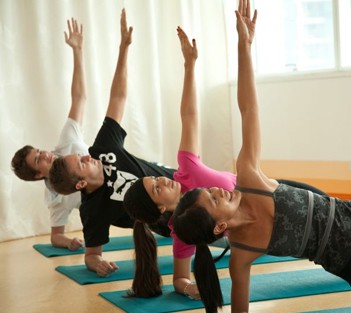Core Stability Classes

Neck and back pain is one of the biggest problems facing people’s health in modern life. Long working hours behind the computer with a poor posture and inactivity weakens your core muscles and lead eventually to neck and back pain. However, regular core stability exercise can improve your back muscles and your posture. This will help to get rid of irritating pain during daily activities, at work and during sports.
Everybody can join our Core Stability group at any time. You don’t have to be a patient at PhysioActive. If you are not sure if the Core Stability group is suitable for your condition or you never had any instructions activating your core muscles, we offer one-on-one sessions. This will give you an optimal preparation to start with the group.
The group will have no more than 6 participants ensuring everybody gets full attention from the instructor. This guarantees a proper performance of the exercises, which makes the outcome of the session most effective.
Goals:
- Learn to activate and control your core muscles in different positions
- Optimize your core stability
- Strengthen your core muscle
- Get rid of irritating back- and neck pain
- Improve your posture
- Increase your general well-being
Benefits of core stability:
- Reduced risk of injury
- Improved posture
- Improved sport performance
- More efficient use of muscle power, as less effort is lost in compensatory movements in the trunk
- Improved balance and muscular coordination
“In summary, your body can function more efficiently with less risk of injury”
What is core stability?

Our spine, which allows us to an upright posture, is stabilized by specific muscles which are attached to the vertebras. These are called the core stability muscles.
Your core is not just your back, but also the pelvic and shoulder girdle, which are responsible for transferring the forces of your arms and legs to your spine.
Core stability is the ability of your trunk to support your arms and legs, in order that muscles and joints can perform in their safest, strongest and most effective positions. The body will start to compensate when the wrong muscles are activated to initiate a movement or when the core muscles are weak. This can lead to overuse and irritation of the joints and a poor posture. When this happens, you lose efficiency, and this will result in a loss of power. It can also make you vulnerable to injuries such as shoulder tendonitis, lower back- and neck pain and hip pain.
Core stability and low back/neck pain
Research has shown that the muscles responsible for supporting the lower back are the very same muscles which stop working effectively when back pain is present! Whether you are involved in an athletic pursuit or not, these muscles are necessary to control movement of the trunk and limbs, and to limit excessive stress on the spine. Development of a strong, stable trunk or core is essential to recover from a back injury, even if you just want to return to everyday tasks.
